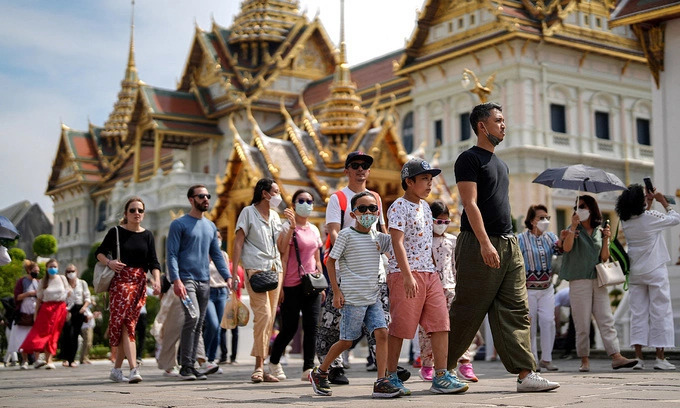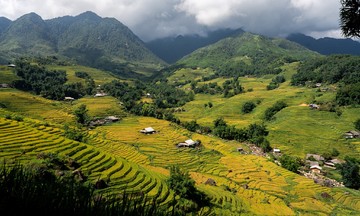Thailand's hotel industry is facing pricing pressure this year after four years of growth, with average room rates doubling since 2021. According to an August report by Tris Rating, the main reason for the price drop is a sharp decrease in tourists from China and several key Asian markets.
Tris Rating, Thailand's first and largest credit rating agency, forecasts that the total number of international tourists to Thailand this year will reach 33 million, a 5.6% decrease compared to 35.5 million in 2024. The decline mainly comes from key markets such as China, Malaysia, and South Korea.
 |
Tourists visit the Grand Palace in Bangkok, Thailand. Photo: Reuters |
Tourists visit the Grand Palace in Bangkok, Thailand. Photo: Reuters
Besides Tris, many other research organizations also offer pessimistic forecasts. Kasikorn Research Center predicts that Thailand's hotel industry will experience its first decline in five years, with 2025 revenue potentially dropping by nearly 5%.
The report identifies several factors contributing to the downturn in Thailand's hotel industry. The decline in international tourists has led to a shorter average length of stay.
Room capacity and prices have decreased. In the first seven months of the year, the national average room capacity reached over 71%, a 0.2% decrease compared to the same period last year. The year-round occupancy rate is forecast to decrease by 2%, down to approximately 70%. The average room rate could also drop by 4% this year, following a 5% decrease in the first seven months.
With fewer international events and concerts, revenue from meetings, incentives, conferences, and exhibitions (MICE) has shrunk. In the first half of the year, the number of domestic and international MICE events decreased by 13% compared to the same period last year.
Hotels face escalating operating costs, especially labor costs. Due to sluggish travel demand and fierce competition, hotels cannot raise room rates accordingly to compensate, forcing them to bear most of the additional costs.
Kasikorn's report also notes that the impact of this downturn is not uniform, with some hotel groups facing greater risks. Hotels dependent on international tourists in Bangkok, Chon Buri, Songkhla, and Chiang Mai, especially those serving East Asian guests, are particularly vulnerable. These locations have high competition due to the large supply of rooms.
Hotels in border areas, such as Sa Kaeo and Ubon Ratchathani, are affected by tensions along the Thai-Cambodian border.
According to Tris, the hotel occupancy rate in Thailand in 2024 reached its highest level since the pandemic and even surpassed pre-pandemic levels. However, this growth is difficult to maintain in 2025, as the decline in international tourists and cautious consumer sentiment overshadow the growth of domestic tourism.
To maintain market share and room capacity, hotels are forced to reduce prices. Tris forecasts that occupancy rates will remain flat or decrease slightly this year.
Tris's report indicates that the post-Covid boom has ended. Currently, the number of international tourists, especially from China, is declining while the supply of hotels continues to increase.
The central and southern regions still contribute the most to room revenue. The competitive price reduction has eroded average prices, especially at high-end hotels in Bangkok. Many hotels have to offer hidden promotions and selective discounts during the low season to maintain capacity.
 |
A hotel in central Bangkok. Photo: IGH |
A hotel in central Bangkok. Photo: IGH
Maybank Securities (Thailand) shares the same view, forecasting that revenue per available room (RevPAR) of seven major hotel groups listed on the Thai stock exchange will decrease by 3% in Quarter III compared to the same period last year, although this decrease is smaller than the 5% drop in Quarter II.
These groups dominate the market, owning and operating numerous hotels from high-end to mid-range across the country, so their revenue trends clearly reflect the overall industry trend.
In the first eight months of the year, Thailand welcomed 21.9 million international tourists, a 7.2% decrease compared to the same period last year, according to the Ministry of Tourism and Sports. The decline has been partially offset by the rapidly growing Indian market, which has risen to the top five largest source markets with over 15 cities having direct flights to Bangkok and Phuket. Tourists from distant markets like the US and Europe also recorded positive growth. However, this increase is not enough to compensate for the gap left by the Chinese market, which once accounted for nearly one-third of the total international tourists to Thailand.
Mai Phuong (Bangkok Post)












